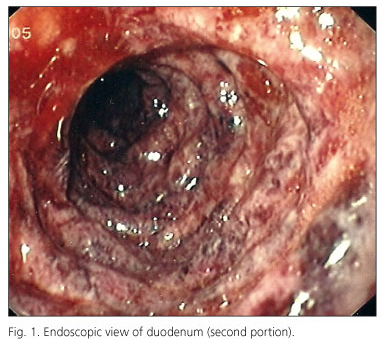My SciELO
Services on Demand
Journal
Article
Indicators
-
 Cited by SciELO
Cited by SciELO -
 Access statistics
Access statistics
Related links
-
 Cited by Google
Cited by Google -
 Similars in
SciELO
Similars in
SciELO -
 Similars in Google
Similars in Google
Share
Revista Española de Enfermedades Digestivas
Print version ISSN 1130-0108
Rev. esp. enferm. dig. vol.102 n.5 Madrid May. 2010
PICTURES IN DIGESTIVE PATHOLOGY
Acute mesenteric ischemia
Isquemia mesentérica aguda
B. Arroja1, M. Canhoto1, C. Gonçalves1, F. Silva1, I Cotrim1, H. Vasconcelos1 and M. Vilela2
Departments of 1Gastroenterology and 2Radiology. Hospital de Santo André. EPE, Leiria. Portugal
Case report
A 76 year-old male with a mitral valve mechanical prosthesis under chronic warfarin therapy was admitted at our hospital with hematemesis and abdominal pain with onset five hours earlier.
The patient was anxious, his heart rate was 98 bpm (beats per minute) and blood pressure 90/40 mmHg. On auscultation a cardiac metallic sound was heard while pulmonary sounds were normal. The abdomen was mildly distended without rebound reaction and bowel sounds were present. Digital rectal examination did not show melena.
Blood analysis: hematocrit 39.4%, platelet count 144.0 x103/mL, Internacional normalized ratio 4.03, activated partial thromboplastin time 29.6 seconds, creatinine 2.1 mg/dL, blood urea nitrogen 42.8 mg/dL, serum albumin 19 g/L, AST 906 U/L, ALT 728 U/L, total bilirubin 3.2 mg/dL, conjugated bilirubin fraction 1.8 mg/dL, DHL 3787 U/L.
Esophagogastroduodenoscopy visualized congestive, ulcerated and necrotic appearance of the mucosa of gastric fundus and body, second and third (Fig. 1) portions of the duodenum, with blood oozing from these sites suggesting major gastrointestinal ischemia. The gastric antrum and duodenal bulb were spared.
Computed tomography scan confirmed acute mesenteric ischemia through indirect typical imaging findings (Fig. 2).
Enoxaparin 1 mg/kg subcutaneously every 12 hours was started and albeit significant clinical, radiological and endoscopic improvements were initially registered, the patient died one month after admission of nosocomial pneumonia.
Discussion
The diagnosis of acute mesenteric ischemia is not always easy to accomplish and depends on an elevated index of suspicion (1). Abdominal pain and distension in an elderly patient with previous history of cardiovascular pathologic previous events is a common presentation (2). Gastrointestinal bleeding manifested with hematemesis is rare. Currently, imaging techniques have yielded important clarification of this serious condition. The combination of pneumatosis intestinalis and portomesenteric venous gas seen on computed tomography (CT) scan is highly suggestive of severe bowel ischemia (1,3). Endoscopic findings of bowel infarction may add important documentation to this condition (4).
References
1. Oldenburg WA, Lau LL, Rodenberg TJ, Edmonds HJ, Burger CD. Acute mesenteric ischemia: a clinical review. Arch Intern Med 2004; 164(10): 1054-62. [ Links ]
2. Finucane PM, Arunachalam T, O'Dowd J, Pathy MS. Acute mesenteric infarction in elderly patients. J Am Geriatr Soc 1989; 37(4): 355-8. [ Links ]
3. Lai WH, Hwang TL, Chen HW. Portomesenteric venous gas in acute bowel ischemia: report of a case. Surg Today 2008; 38(7): 656-60. [ Links ]
4. Seno H, Mikami S, Komatsu K, Kadota S, Yazumi S, Chiba T. Ischemic duodenitis. Endoscopy 2005; 37(1): 91. [ Links ]















